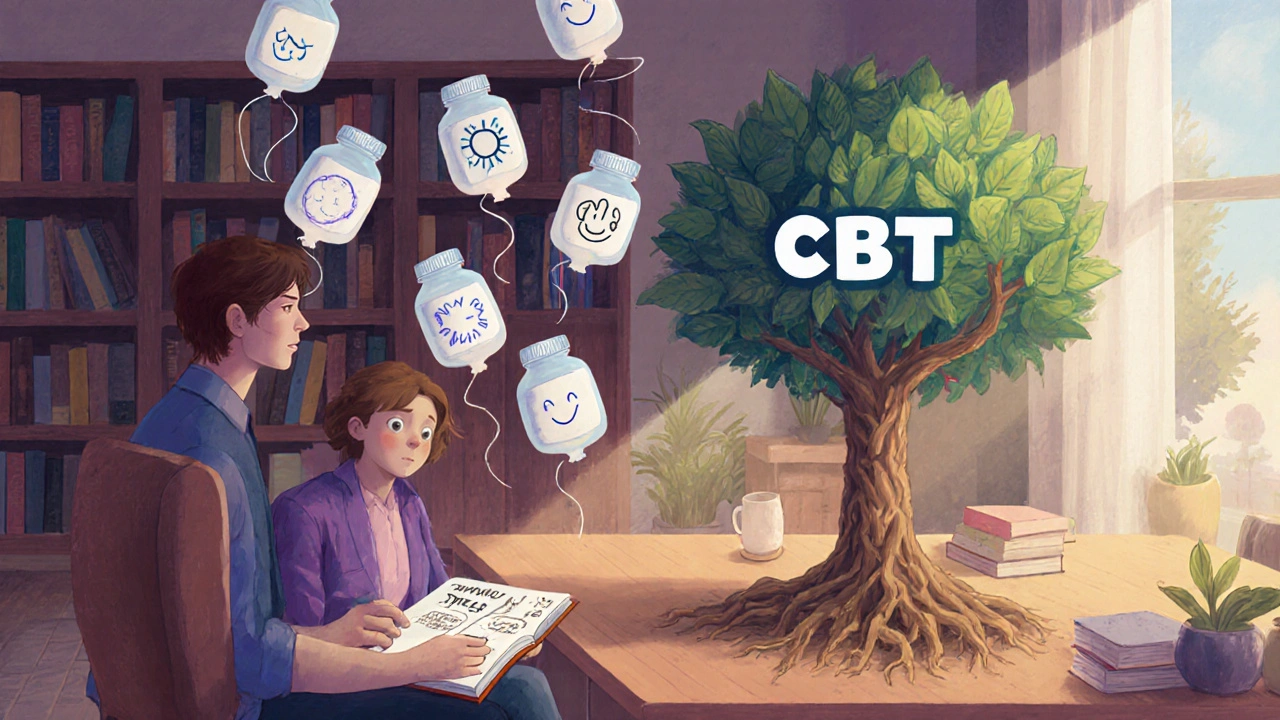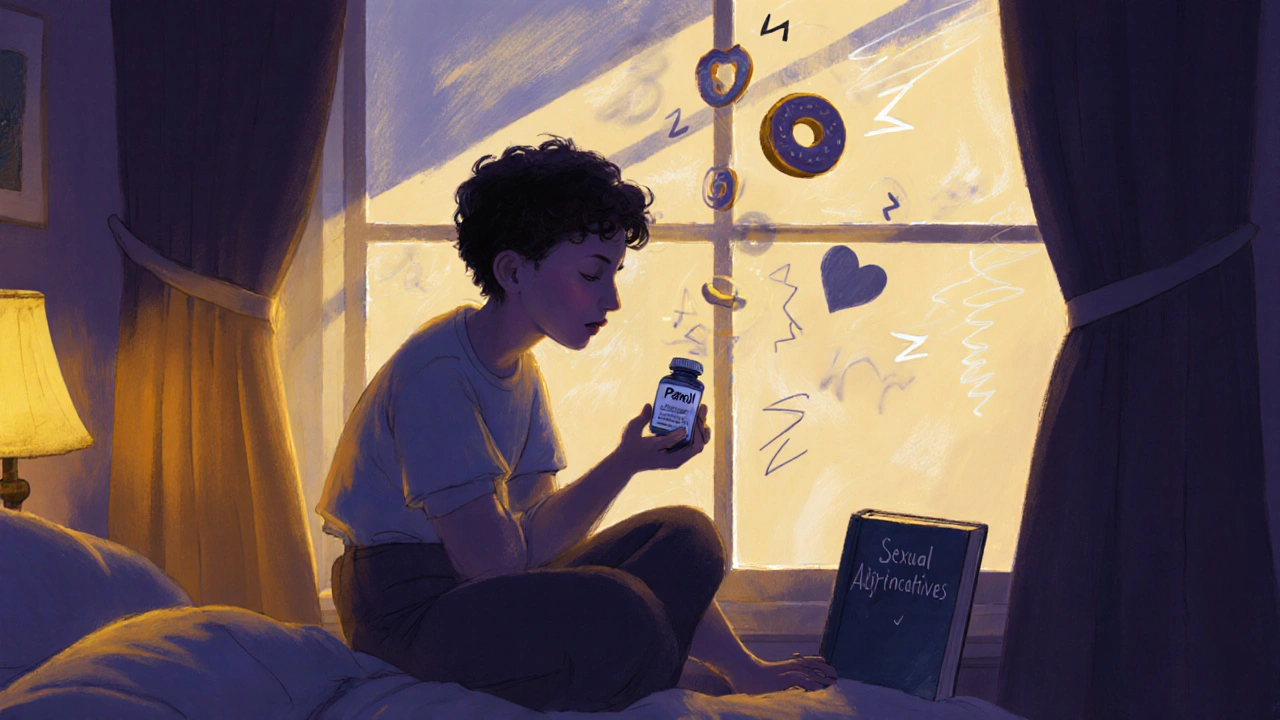If you’re taking Paxil (paroxetine) for anxiety or depression and wondering if there’s a better option, you’re not alone. Many people start on Paxil because it’s been around for decades and is widely prescribed. But side effects like weight gain, sexual dysfunction, or drowsiness can make it hard to stick with. Others find it just doesn’t work well enough. That’s when the real question comes up: Paxil vs. alternatives - which one fits your life, body, and goals?
What Paxil Actually Does
Paxil is the brand name for paroxetine, a selective serotonin reuptake inhibitor (SSRI). It works by increasing serotonin levels in the brain, which helps regulate mood, sleep, and anxiety. It’s FDA-approved for major depressive disorder, generalized anxiety disorder, panic disorder, social anxiety disorder, and PTSD.
But here’s the catch: Paxil has one of the highest rates of side effects among SSRIs. In clinical trials, up to 40% of users reported sexual side effects like lowered libido or difficulty reaching orgasm. Weight gain is common too - studies show an average increase of 2-5 pounds over six months. And because it has a short half-life (about 21 hours), missing a dose can trigger withdrawal symptoms like dizziness, nausea, or brain zaps.
How Paxil Compares to Other SSRIs
Not all SSRIs are the same. Here’s how Paxil stacks up against three other common ones:
| Medication | Common Side Effects | Half-Life | Weight Gain Risk | Withdrawal Risk |
|---|---|---|---|---|
| Paxil (paroxetine) | Drowsiness, dry mouth, sexual dysfunction, nausea | 21 hours | High | High |
| Prozac (fluoxetine) | Insomnia, nervousness, upset stomach | 4-6 days | Low | Low |
| Cipralex (escitalopram) | Mild nausea, fatigue, occasional insomnia | 27-32 hours | Moderate | Moderate |
| Sertraline (Zoloft) | Diarrhea, dizziness, sleep changes | 26 hours | Moderate | Moderate |
Prozac stands out because of its long half-life. If you forget a dose, your body still has enough in your system to avoid withdrawal. That’s why many doctors switch patients from Paxil to Prozac when they’re trying to taper off. Cipralex is often preferred for anxiety because it’s more targeted and tends to cause fewer side effects than Paxil. Sertraline is the most commonly prescribed SSRI in the U.S. - not because it’s the strongest, but because it’s the most balanced for most people.
SNRIs: A Different Approach
If SSRIs aren’t working or side effects are too much, doctors often turn to SNRIs - serotonin-norepinephrine reuptake inhibitors. These affect two neurotransmitters instead of one.
Effexor (venlafaxine) and Cymbalta (duloxetine) are the two most common. Both can be more effective than SSRIs for severe depression or chronic pain tied to anxiety. But they come with trade-offs. Effexor can raise blood pressure, especially at higher doses. Cymbalta may cause more nausea and dry mouth than Paxil.
One key advantage: SNRIs often have less sexual side effect burden than Paxil. A 2023 meta-analysis found that 22% of SNRI users reported sexual dysfunction, compared to 38% on Paxil. That makes SNRIs a strong alternative if sexual health is a priority.

Non-SSRI Options: Beyond Antidepressants
Not everyone needs another antidepressant. Some people benefit from switching to a different class of medication entirely.
Mirtazapine (Remeron) is an atypical antidepressant that doesn’t block serotonin reuptake. Instead, it increases serotonin and norepinephrine by blocking certain receptors. It’s known for helping with sleep and appetite - great if you’re underweight or struggling with insomnia. But it often causes weight gain and drowsiness, so it’s not ideal for daytime use.
Bupropion (Wellbutrin) is unique because it doesn’t affect serotonin at all. It targets dopamine and norepinephrine. That’s why it’s the go-to choice for people who can’t tolerate sexual side effects. It’s also less likely to cause weight gain - some even lose a little. But it can increase anxiety in the first few weeks and isn’t recommended for people with seizure disorders.
Buspirone (Buspar) isn’t an antidepressant, but it’s approved for generalized anxiety. It works differently - targeting serotonin receptors without reuptake inhibition. It doesn’t cause dependency, doesn’t cause sexual side effects, and doesn’t make you drowsy. But it takes 2-4 weeks to work and isn’t strong enough for depression.
When to Consider Therapy Instead
Medication isn’t the only tool. For mild to moderate depression and anxiety, therapy can be just as effective - and longer-lasting.
Studies from the National Institute of Mental Health show that cognitive behavioral therapy (CBT) works as well as SSRIs for anxiety disorders, and the benefits last longer after stopping treatment. Many people combine therapy with medication, but some find they can stop the drug entirely after 3-6 months of consistent therapy.
If you’ve tried Paxil and it didn’t help, or you stopped because of side effects, therapy might be the missing piece. It’s not a quick fix, but it teaches skills you can use for life - not just while the pill is in your system.
What’s Best for You?
There’s no universal “best” alternative to Paxil. The right choice depends on your symptoms, side effect tolerance, lifestyle, and goals.
- If you want minimal withdrawal risk: Go with Prozac.
- If you care most about sexual side effects: Try bupropion or an SNRI like Cymbalta.
- If you struggle with sleep or appetite: Mirtazapine might help.
- If you have chronic pain with anxiety: Cymbalta could be the answer.
- If you’re looking for a non-medication option: Start CBT.
Also, don’t assume switching meds will be easy. Tapering off Paxil too fast can cause severe withdrawal. Always work with your doctor. A slow, gradual switch - often overlapping the new medication while slowly reducing Paxil - is the safest way.

What to Ask Your Doctor
Before you ask to switch, come prepared. These questions help guide the conversation:
- Could my side effects be from Paxil, or something else?
- What’s the most likely reason Paxil isn’t working for me?
- What are the pros and cons of switching to [specific alternative]?
- How will we safely reduce my Paxil dose?
- Will I need to try more than one option before finding the right fit?
Doctors aren’t mind readers. The more specific you are about what’s not working - whether it’s fatigue, lack of sex drive, or feeling emotionally numb - the better they can help.
Real Stories, Real Choices
One patient, 34, switched from Paxil to sertraline after gaining 18 pounds and losing interest in sex. Within three months, she lost 10 pounds and felt like herself again. Another, 51, tried Cymbalta after Paxil failed to help his chronic back pain and anxiety. He got relief from both - but had to manage nausea for the first two weeks.
Not everyone finds a perfect match. Some try three or four meds before finding one that works. That’s normal. It’s not failure - it’s trial and error, and it’s part of the process.
Is Paxil still a good choice for anxiety?
Paxil can work well for anxiety, especially panic disorder and social anxiety. But because of its high side effect profile - particularly sexual dysfunction and withdrawal symptoms - it’s often not the first choice anymore. Many doctors now start with sertraline or escitalopram instead. Paxil is still used, but usually after other options have been tried.
Can I switch from Paxil to Prozac on my own?
No. Switching antidepressants without medical supervision can lead to dangerous withdrawal symptoms or serotonin syndrome. Paxil leaves your system quickly, so stopping it abruptly can cause dizziness, nausea, and brain zaps. Prozac builds up slowly, so switching requires a careful overlap and taper plan. Always work with your doctor.
Which alternative has the least side effects?
Escitalopram (Cipralex) and sertraline (Zoloft) generally have the mildest side effect profiles among SSRIs. For sexual side effects, bupropion (Wellbutrin) is the best option since it doesn’t affect serotonin. But no medication is side-effect-free. The goal is finding the one with the least impact on your daily life.
How long does it take for alternatives to work?
Most antidepressants take 4-6 weeks to show full effects. Some people feel small improvements in 1-2 weeks, but don’t give up before 6 weeks unless side effects are unbearable. If you switch from Paxil, your doctor may overlap the new med for 1-2 weeks to avoid withdrawal before fully stopping Paxil.
Will I gain weight on any of these alternatives?
Weight gain varies. Paxil and mirtazapine are most likely to cause it. Prozac and bupropion are least likely - some people even lose weight on bupropion. Sertraline and escitalopram usually cause little to no weight change. If weight is a concern, discuss this upfront with your doctor.
Is therapy better than medication?
For mild to moderate anxiety and depression, therapy - especially CBT - is just as effective as medication, and the results last longer. For severe cases, combining therapy with medication often works best. Therapy doesn’t fix everything overnight, but it gives you tools to manage symptoms long after the medication ends.
Next Steps
If you’re thinking about switching from Paxil, start by tracking your symptoms and side effects for two weeks. Write down what’s working, what’s not, and how you feel day to day. Bring this list to your doctor. Don’t wait until you’re miserable - early conversations lead to better outcomes.
Remember: Finding the right treatment isn’t about finding the perfect drug. It’s about finding the one that lets you live your life - without constant side effects, without feeling numb, without being stuck. Paxil helped many people. But for a lot of others, there’s something better waiting - if you’re willing to look for it.


10 Comments
Scott Dill
I switched from Paxil to Wellbutrin last year and my sex drive came back like I was 19 again. No more brain zaps either. Best decision I ever made.
Amanda Nicolson
Okay but can we talk about how Paxil made me feel like a zombie who forgot how to laugh? I was crying at commercials, couldn’t finish a sentence without zoning out, and gained 22 pounds in six months. I switched to sertraline and suddenly I remembered what coffee tasted like. It’s not just side effects - it’s like your soul gets put on pause. I’m not saying it doesn’t work for people, but if you’re feeling emotionally numb, it’s not just ‘you’re getting better’ - it’s your brain on mute. And then you realize you haven’t smiled at a stranger in months. That’s not recovery. That’s survival with a side of dissociation.
Kathy Pilkinton
Of course you’re all talking about meds like they’re ice cream flavors. You think this is a menu? You think your doctor’s just handing out samples? You people have no idea how many lives are ruined by doctors who treat mental health like a quick fix. I had to beg for a switch from Paxil for two years because my doctor kept saying ‘give it more time.’ Meanwhile I was crying in the shower every morning because I couldn’t even enjoy my own damn birthday. Therapy didn’t help until I finally got off that damn pill. So stop acting like it’s just ‘trial and error.’ It’s negligence wrapped in a prescription.
shivam mishra
As someone from India who’s seen both Western and Ayurvedic approaches - SSRIs aren’t magic, but they’re not the devil either. I’ve had patients on Paxil who did fine, others who crashed. What matters is dosage, timing, and whether they’re eating properly. In India, we often skip meals when depressed - that makes side effects worse. Also, people here don’t talk about sexual side effects. Ever. So they just quit cold turkey. Bad idea. Talk to your doctor. And if they don’t listen, find another one. Your mental health isn’t a second priority.
Jackson Olsen
Prozac is the real MVP for tapering. I was on Paxil for 3 years. Tried to quit cold turkey - brain zaps for a week straight. Switched to Prozac slowly over 8 weeks. Zero withdrawals. Felt like my brain finally stopped screaming. Also lost 8 lbs. No joke. Wellbutrin gave me anxiety. Cipralex made me tired. Prozac just worked. Don’t overthink it.
Holly Dorger
Just want to say thank you for writing this. I’ve been on Paxil for 5 years and thought I was broken because I couldn’t get off it. Turns out it’s just the worst SSRI for withdrawal. My therapist recommended switching to sertraline and I was terrified. But we did it slowly. Took 3 months. I still get a little dizzy sometimes but I can hold my partner’s hand again without feeling like a robot. This post saved me from giving up.
Penny Clark
OMG I JUST REALIZED I’VE BEEN TAKING PAXIL FOR 4 YEARS AND NEVER KNEW IT HAD SUCH A SHORT HALF LIFE 😭 I MISSED A Dose LAST WEEK AND FELT LIKE I WAS IN A TORNADO. NOW IT MAKES SENSE. I’M TALKING TO MY DOCTOR MONDAY. THANK YOU FOR THIS. I FEEL LESS ALONE.
Mike Gordon
So many people say therapy is better than meds but nobody talks about how hard it is to find a good therapist who takes your insurance and isn’t booked for six months. I waited 11 months. By then I was on Paxil and barely functional. Therapy helped but it didn’t save me - the med did. Don’t shame people for needing pills. We’re not lazy. We’re just trying to survive.
Arrieta Larsen
I tried everything. Paxil, Zoloft, Cymbalta, Wellbutrin. Nothing worked until I added mindfulness meditation. Not a miracle. Just… quiet. For the first time in years, I could sit with my thoughts without panicking. It didn’t fix everything, but it gave me space to breathe. If you’re on meds, don’t give up on yourself. But don’t ignore the non-pill stuff either. It’s not either/or. It’s both.
Niki Tiki
Why do Americans always think they need a pill for everything? In my country we just go outside and walk. We talk to our families. We eat real food. You don’t need a prescription to fix your mind. You need to stop being so soft.